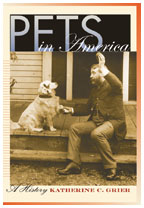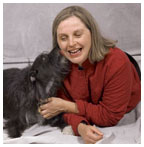May 10, 2006: Reading Room
In her book, Katherine C. Grier ’75, pictured with her dog Patti, looks at people’s relationship with their pets. (Phil Sawyer Jr.) |
The
making of Rover and Fluffy
Katherine C. Grier ’75 explores the history
of pets in America
By Carol Zall ’88
As a social historian, Katherine C. Grier ’75 is interested in reconstructing the untold history of everyday life and giving voice to those who cannot tell their own stories. It makes sense, then, that her latest book, Pets in America: A History, should focus on what she calls the “profoundly voiceless” members of our communities, the animals that live and work among us.
 Published
by the University of North Carolina Press in February, Pets in America
lays claim to being the first comprehensive history of pet-keeping in
the United States. In it, Grier provides a chronicle of the relationship
between people and animals from the late 18th century to the present,
as well as a wide-ranging discussion of how that relationship has changed.
Our modern ideas about pets, she argues, are a legacy of the 19th century’s
“domestic ethic of kindness,” which transformed the way people
regarded the animals they lived with and has led to our seeing pets less
as working animals and more “as friends, family members, innocent
dependents, or even children.”
Published
by the University of North Carolina Press in February, Pets in America
lays claim to being the first comprehensive history of pet-keeping in
the United States. In it, Grier provides a chronicle of the relationship
between people and animals from the late 18th century to the present,
as well as a wide-ranging discussion of how that relationship has changed.
Our modern ideas about pets, she argues, are a legacy of the 19th century’s
“domestic ethic of kindness,” which transformed the way people
regarded the animals they lived with and has led to our seeing pets less
as working animals and more “as friends, family members, innocent
dependents, or even children.”
Viewed as a way to socialize children to be good citizens in the 19th century, pet ownership increasingly has become our only contact with the animal world, and our involvement with our pets has become more intimate. Grier’s discussion covers the entire spectrum of American pets, from the white mice and bunnies considered to be good children’s pets in the 19th century, to the exotic reptilian pets cherished in some households today. She also examines how the development of the pet-food industry reflects the emergence of modern consumer society.
Grier treats readers to many intriguing details, such as the popularity of caged songbirds in the 19th and early 20th centuries. In a world with no recorded music, birds were the ambient sound of the household, providing company for shut-ins and women who worked alone at home, writes Grier. However, with the arrival of the phonograph and then the radio in the 1920s and 30s, their popularity as pets waned.
For Grier, who has two dogs and two cats, pets have always been important. Her first spoken word was “kitty.” Says Grier, “When you do the history of everyday life, your own life is a way to start the research. ... You can [begin by asking,] ‘I’m taking this cat for these shots and spending all this money; when did people start doing that?’”
A professor of material culture studies who uses objects to study the
history of everyday, domestic life, Grier holds a joint appointment with
the Winterthur Museum Program in Early American Culture and the University
of Delaware’s history department. One thing that really surprised
Grier was how far back she found people giving their pets burials. One
family in 1800 performed a ceremony with prayers on the family grounds
for a beloved cat. Today some people think pet owners who use pet cemeteries
are ridiculous, Grier says, “but what I’m finding is that
a lot of this stuff goes back much farther than we thought.” ![]()
Carol Zall ’88 is a freelance writer in Cambridge, Mass.
BOOK SHORTS
 The Lightning
Keeper — Starling Lawrence ’65 (HarperCollins). Set
during World War I, this novel follows Toma Pekocevic, a poor immigrant,
who falls in love with an heiress to an iron-making dynasty. He invents
a water turbine, but problems ensue after his invention malfunctions.
As he tries to perfect his machine, which could revolutionize electricity,
General Electric becomes interested. Lawrence is the editor-in-chief of
W.W. Norton.
The Lightning
Keeper — Starling Lawrence ’65 (HarperCollins). Set
during World War I, this novel follows Toma Pekocevic, a poor immigrant,
who falls in love with an heiress to an iron-making dynasty. He invents
a water turbine, but problems ensue after his invention malfunctions.
As he tries to perfect his machine, which could revolutionize electricity,
General Electric becomes interested. Lawrence is the editor-in-chief of
W.W. Norton.
 The Electric
Life of Michael Faraday — by Alan Hirshfeld ’73 (Walker).
The author traces Faraday’s life, from his birth into poverty in
1791 in London and his training as a bookbinder to his rise through the
ranks of the scientific elite. Faraday laid the groundwork of our technological
society by inventing the electric generator and electric motor. Hirshfeld
is a professor of physics at the University of Massachusetts–Dartmouth.
The Electric
Life of Michael Faraday — by Alan Hirshfeld ’73 (Walker).
The author traces Faraday’s life, from his birth into poverty in
1791 in London and his training as a bookbinder to his rise through the
ranks of the scientific elite. Faraday laid the groundwork of our technological
society by inventing the electric generator and electric motor. Hirshfeld
is a professor of physics at the University of Massachusetts–Dartmouth.
 Charles Rose,
Architect — Charles Rose ’83 (Princeton Architectural
Press). In this monograph featuring some of his architectural projects
— from a house on Cape Cod to a campus center at Brandeis University
— Rose describes the design and structural elements of each building
and includes colorful photographs of the projects. The New York Times
has described Rose as “an architect who is distinguishing himself
with public structures and houses of ethereal lines, space, and light.”
Charles Rose,
Architect — Charles Rose ’83 (Princeton Architectural
Press). In this monograph featuring some of his architectural projects
— from a house on Cape Cod to a campus center at Brandeis University
— Rose describes the design and structural elements of each building
and includes colorful photographs of the projects. The New York Times
has described Rose as “an architect who is distinguishing himself
with public structures and houses of ethereal lines, space, and light.”
![]()
By K.F.G.
For a complete list of books received, click here.

